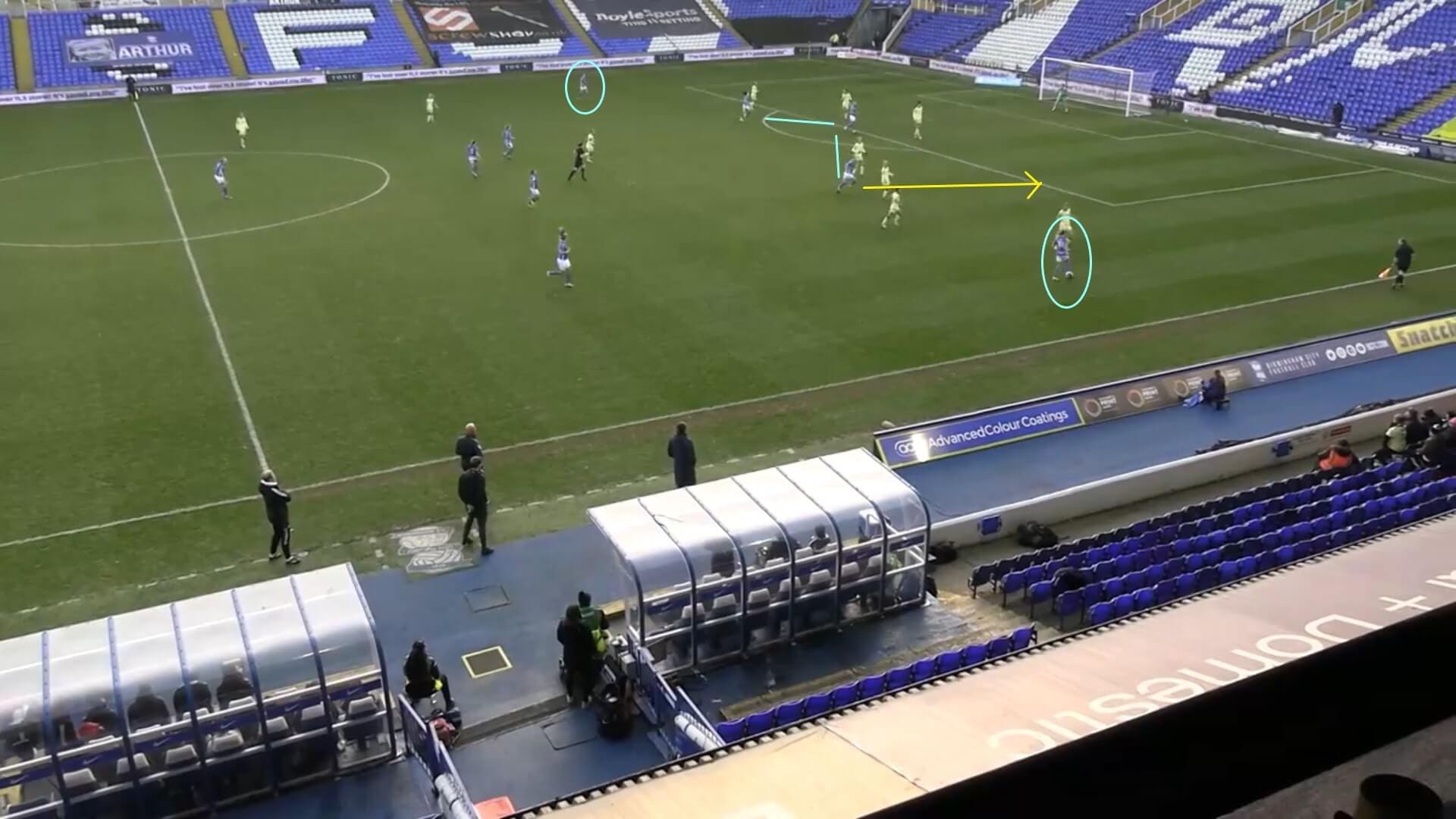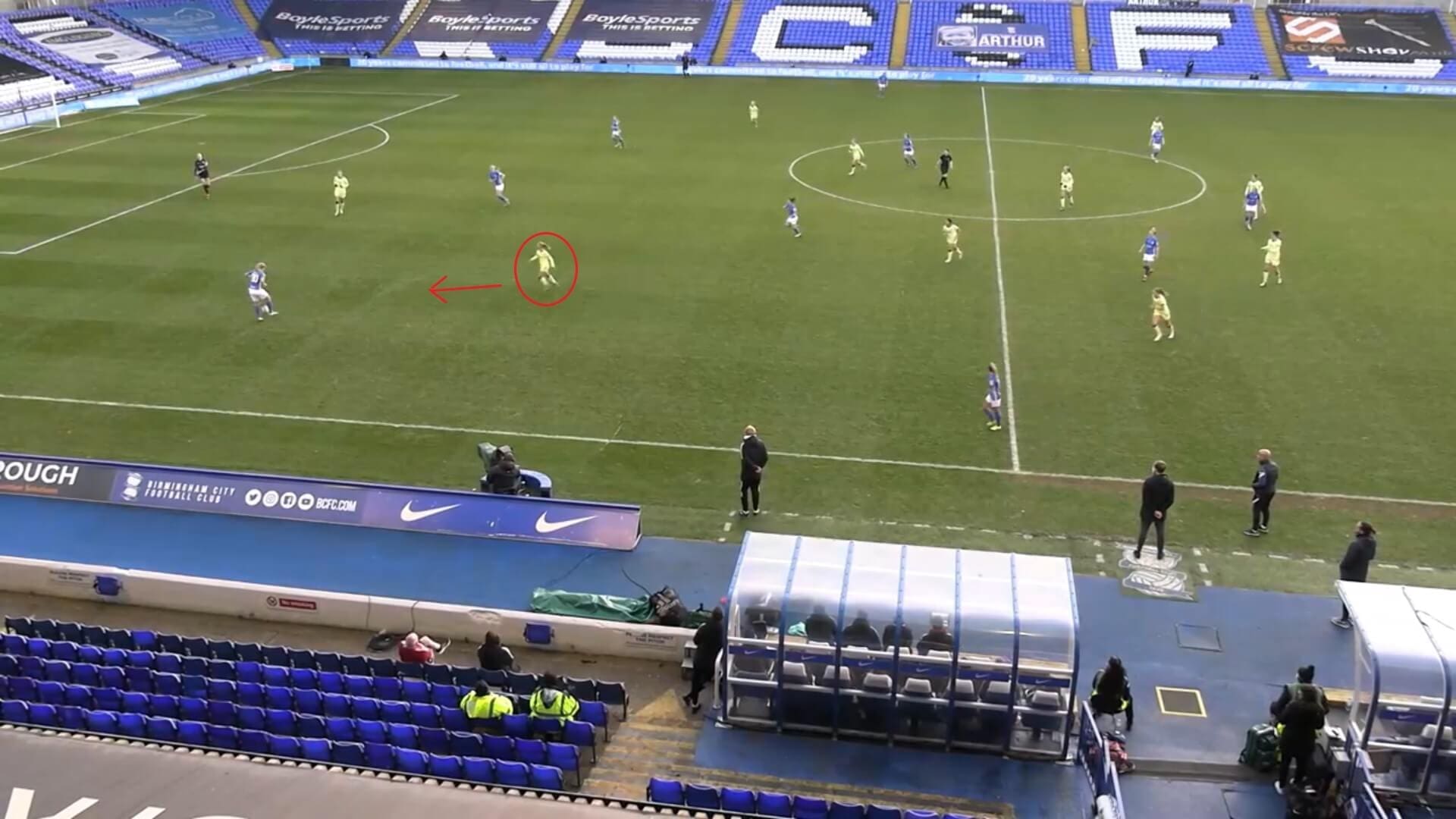After a short break over the festive period, the WSL returned to us with just three fixtures going ahead. One of those was league leaders Arsenal Women’s trip to struggling Birmingham City Women, who had only picked up a solitary point from a possible 30 so far. Meanwhile, Arsenal had yet to lose a league game in 2021/2022, so it was undeniably the biggest shock so far when Birmingham claimed all three points and became only the third team to prevent Arsenal from scoring during the current campaign (alongside Barcelona Femeni and Chelsea Women).
However, as this tactical analysis will demonstrate, Darren Carter’s side were good value for their win, with some well-thought-out tactics the secret to their success. The analysis will look at how they set up defensively in a way that frustrated Arsenal and prevented Jonas Eidevall’s side from playing to their strengths, whilst also indicating how their attacking quality ensured that that defensive robustness was rewarded with the win.
Lineups

Birmingham City Women made just two changes to the side that lost to fellow strugglers Leicester City Women in their last outing. Interim head coach Darren Carter handed a start to on-loan Manchester United Women goalkeeper Emily Ramsey in place of Marie Hourihan, who was unavailable, whilst midfielder Lucy Whipp dropped to the bench and was replaced by Republic of Ireland international Lucy Quinn. Former Liverpool Women midfielder Christie Murray and Greece attacker Veatriki Sarri kept their places in the midfield, whilst striker Libby Smith, who was instrumental in helping Leicester to promotion from the Women’s Championship last season, once again led the line.
Arsenal Women, meanwhile, made four changes to the team that suffered an away defeat to Hoffenheim Frauen in their final Champions League group game. Australia goalkeeper Lydia Williams will be unavailable for the next group of matches, alongside Caitlin Foord and Steph Catley, as all three have joined up with the Matildas’ squad for the Asia Cup. The return of first-choice stopper Manuela Zinsberger was therefore timely, as was Noelle Maritz’s availability, with the Switzerland international also missing the trip to Germany. She took Anna Patten’s place at right-back, with Patten recently sealing a loan move to Aston Villa Women for the rest of the season. The other alterations saw England midfielder Jordan Nobbs and Denmark defender Simone Boye Sorensen come off the bench to start in midfield and defence respectively, replacing Lia Walti and Catley.
Birmingham City Women’s defensive setup
Throughout the game, it was evident that Birmingham City Women had been working hard on the basics, such as defending well and attacking at pace, and had devised a plan to keep Arsenal Women at bay, which involved soaking up pressure and then counter-attacking at speed when they did gain possession.

The organisation of their back line can be seen in this image, with Darren Carter clearly viewing clean sheets as his first priority. This is a good place to start improving his side, as they have conceded the most league goals so far this season (26, two more than relegation rivals Leicester), and it does seem as though he is trying to take them back to last season, when former manager Carla Ward (now in charge of city rivals Aston Villa) tried to make Birmingham hard to break down. As this game proved, defending in this way is one of Birmingham’s biggest strengths, but only when every player buys into it, and the fact that there was this unity and sense that everyone knew their roles was one reason that Arsenal found it hard to break through them.
Whilst the back line was rigid when the team were out of possession, the midfielders and forwards were free to move around the pitch and dominate the central areas, knowing that they had this protection behind them. Their aim was to force Arsenal to play the ball out to the wings, where it would be easier to defend potential attacks, and the midfielders and forwards all packed together in the middle to make sure that this was the only option that Arsenal had. When we combine this with the defensive line, we can see why and how Birmingham were able to continually frustrate their opponents, and this was one reason for them keeping a clean sheet.

When Arsenal did manage to get into dangerous areas of the pitch, which mainly came in the second half, Birmingham narrowed up and ensured that there were no gaps available for them to exploit. Arsenal have a good range of passing during games, but they were unable to display that at St. Andrews, as short passes failed to win them much ground and long passes risked interceptions.
Picking up on the long passes being risky, this was once again because of Birmingham’s organised setup, which meant that they were able to dictate how the visitors moved the ball around, knowing that Arsenal would have to play horizontally and towards the wide attackers, which meant that they could get out and make easy interceptions. The defenders never lost their concentration in these situations, which was another reason that they kept Jonas Eidevall’s WSL leaders out.

When Birmingham were in possession, they altered their formation slightly, with one of the three central defenders moving out of the line and leaving a back four, as is demonstrated here. With this setup, Birmingham’s centre-backs provided shorter passing options and the full-backs offered longer ones, so there was nothing special about their structure; it was just basics done well. This was yet another indication that the team had done a lot of hard work on the training ground during the break, with each player knowing their roles at every point of the game, and credit must be given to the coaches for this.
The other advantage of this is that Birmingham were able to isolate Arsenal’s loan striker, Vivianne Miedema, who is the only attacker close to the ball here. Now, if Miedema looked to mark one of the defenders, then the ball could be passed to one of the other three; if she went towards the ball, Emily Ramsey would have the space and options to move it around her and take her out of the game. Therefore, again, we can see how Birmingham’s defensive tactics were important in helping them to control large parts of this game.
Birmingham City Women’s attacking tactics
Whilst Birmingham’s defensive strength was key to their win, they would not have taken the points if the attack had not functioned properly as well, and it was clear that they had been working on this during the break too. As a result, when they did move the ball forwards, the attackers asked questions of the Arsenal defenders, and converting two of their seven shots on target is something that Darren Carter can build on during the remainder of the campaign.

For a team who need to score more goals, deploying one striker was, on paper, a negative approach, and one that risked the striker becoming isolated. However, Libby Smith is the type of player who keeps opposing defenders busy, as Leicester fans will remember. Whenever Birmingham had the ball, she got into these advanced positions and forced the defenders to stay further back, which opened up a gap between them and the rest of the team.
Arsenal’s way of ensuring that this didn’t cause problems was to ask Norway midfielder Frida Maanum to play between the lines, as she is doing here. However, in order to make that work, the two wide forwards, Beth Mead and Mana Iwabuchi, needed to drop back and play almost as wingers, covering the spaces either side of Nobbs and captain Kim Little, who now needed to close the gap through the middle.
This left Miedema on her own at the top, which leads us back to the previous section, when we analysed how Birmingham were able to play around Miedema from a goal kick. This is why the Netherlands international had no support in that situation, and it shows how Birmingham’s attack and defence relied on each other, with each playing its part in ensuring that the home side gained their first WSL win of the season.

Whilst Smith’s positioning was key to the win, arguably Birmingham’s most influential player was Veatriki Sarri. We haven’t really seen the best of the Greece international at Birmingham yet, following her move from Championship side Sheffield United Women last January, but this was the game where she showed her true quality. Whilst she is a natural striker, her midfield role in this game appeared to suit her abilities, as she was given licence to move around and create opportunities for others, as well as to find pockets of space where she could cause problems for the Arsenal players.
Her goal at the end of the first half, which was Birmingham’s second, started with her linking up with right wing-back Jamie Finn, before positioning herself well to turn in the rebound after Jade Pennock’s initial effort was saved. She was a handful all game for Jonas Eidevall’s players, and Birmingham always posed a threat whenever she was on the front foot.

In the second half, Arsenal looked to sit back more and give their beleaguered defence some much-needed protection. In doing so, they tried to narrow up in the middle more and stop Sarri, Smith and others from finding so many spaces in their third. However, this allowed Birmingham to push their wing-backs, Finn and Northern Ireland’s Rebecca Holloway, higher up the pitch to support the attacks, providing players who could then put balls into the box and test the defenders. The detail here that is important to note is that they both kept close to the sidelines, rather than cutting inside, and this forced Arsenal to come out and close them down, which subsequently opened up gaps in the middle for quicker attackers like Pennock to run through.
In preparation for Arsenal opening up in the middle, and because they didn’t need to think about covering the wings, Birmingham overloaded the central areas to ensure that they could create as many opportunities as possible. If we put all of this together, we can see why, even though they didn’t score in the second half, Birmingham always posed a threat.
Arsenal Women’s problems
We have looked extensively at Birmingham City Women’s tactics during this game, but it is worth analysing Arsenal Women’s performance too. We know that Jonas Eidevall has implemented a style of play that revolves around quick passing and constant individual movement, but Birmingham had evidently studied this before the game, coming up with a game plan that kept their opponents at bay.

It has already been mentioned that Birmingham sought to control the central areas when out of possession, forcing Arsenal to move the ball out towards the wings, and that the away side were never able to create chances from these positions during the first half. Normally, we see Noelle Maritz and Katie McCabe providing plenty of threat and supporting the attacks, but this only comes if they are allowed to get beyond the opposing defensive line. However, because Birmingham had five at the back, they could stretch out and block these runs, limiting the influence that Maritz and McCabe had on proceedings.
What this demonstrated was that Arsenal only have one game plan, and, if teams prevent them from implementing it, they don’t have an alternative that they can fall back on. As a result, in the first half, the visitors simply moved the ball across the pitch, but never looked like finding a way through, and this is something that they need to look at when breaking down their performance. It is worth noting that their first clear shot on goal didn’t come until the 37th minute, when Jordan Nobbs fired over with a first-time effort, and this perhaps showed the frustration that the Arsenal players were feeling during this game.

Another key aspect of Arsenal’s style of play is the way they create triangular structures on the wings, using them to move the ball behind defences through quick passes and clever movement. However, Birmingham were once again alive to these, and this image shows how they created a 4-v-3 overload here, putting pressure on Arsenal to move the ball quicker than they would have liked to. As a result, Simone Boye Sorensen ends up hitting her pass too hard and sending it out of play, meaning that the chance to break through was wasted. Again, we can see how Arsenal’s usual tactics weren’t working for them, and they lacked the ability to change before half-time.

Partway through the second half, Jonas Eidevall moved Nobbs out to the wing and gave Iwabuchi a more central role, and this gave Arsenal more of an attacking threat, as Nobbs was able to get alongside Miedema and create a two-pronged attack, whilst Iwabuchi’s strength this season has been making late runs into the box from behind the main attacking line. Like most of her teammates, the Japan international had been quiet in the first half, but was much brighter after this change and gave Birmingham a few more problems. Nobbs also had a little more pace, meaning that Arsenal could close down Birmingham’s players with more urgency and force them to move the ball quicker.
The other positive that came from this was that McCabe was able to link up with Nobbs more than she had been doing with Iwabuchi, and this gave Arsenal a better overall setup in the final third. However, Birmingham were still alive to this increased threat, and we have seen how they anticipated play well and ensured that Arsenal left St. Andrews goalless and frustrated.
Conclusion
In conclusion, there is no doubting that Arsenal are currently an out-of-sorts team, with four defeats in their last five games in all competitions, but they are too good a team to not recover from their current poor form. Jonas Eidevall said afterwards that they need to get back to basics, and this will help them to build again and continue their challenge for a first league title since 2018-2019. Darren Carter’s Birmingham, meanwhile, were brave by sticking to their plan, and will be delighted with the result it brought them, as it meant that they climbed above Leicester and out of the relegation zone. However, they can’t get too carried away, as they are still only one point above Leicester, so there is still a lot of work for them to do if they are to keep their place in the top flight.
Birmingham’s next game, barring any postponements, sees them travel to Manchester United Women on Saturday afternoon, when they will be hoping to repeat this performance and keep Marc Skinner’s side at bay. Arsenal, meanwhile, host a resurgent Reading Women on Sunday, and will hope that they can quickly get back to winning ways.




Comments